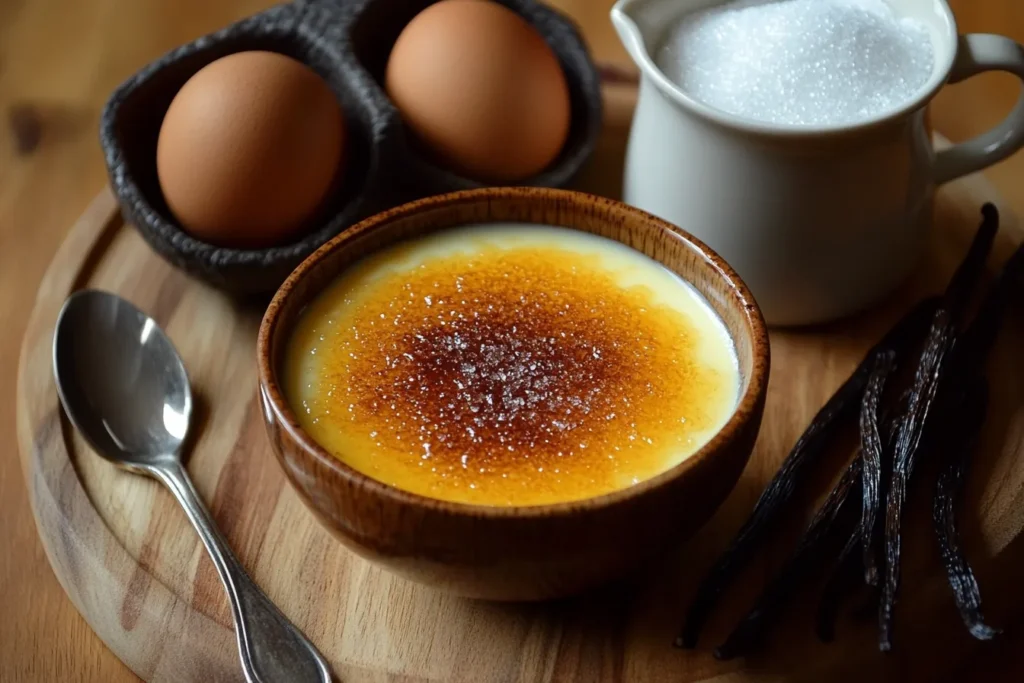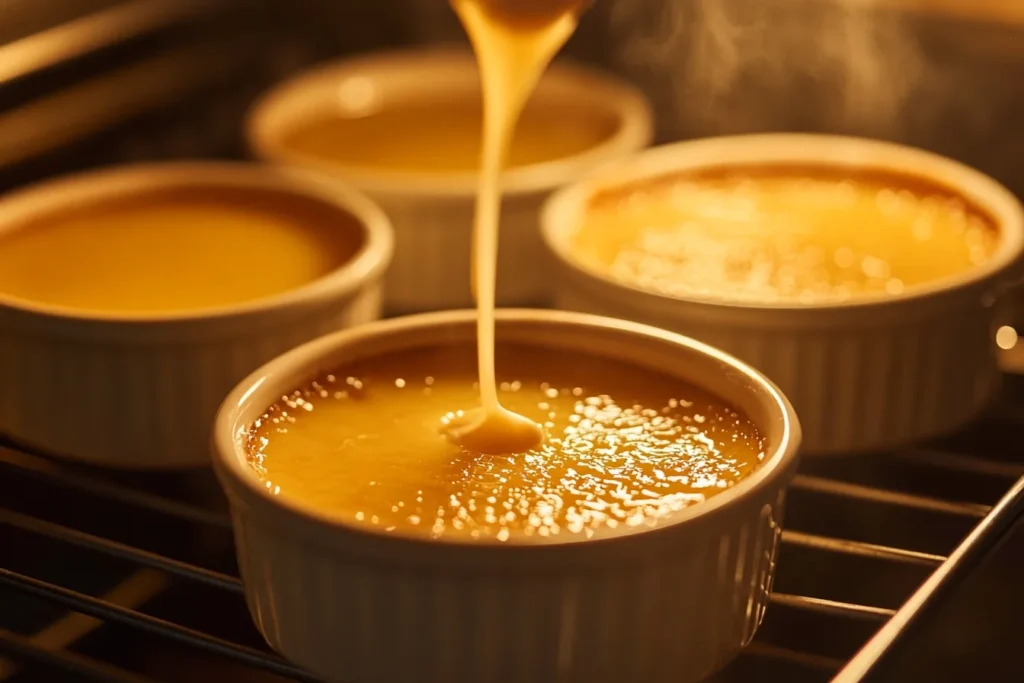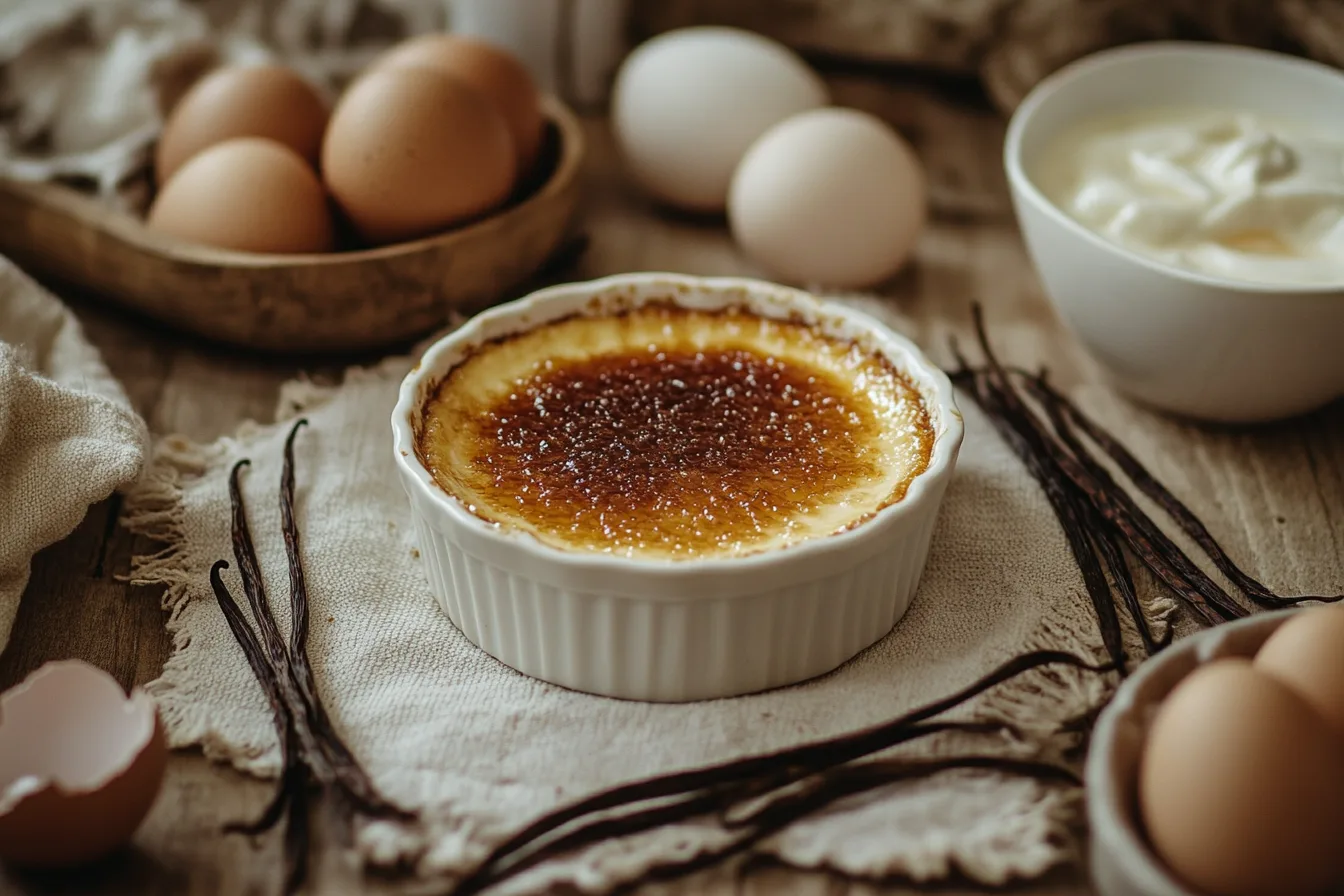Crème brûlée is a timeless dessert that’s as elegant as it is delicious. Its rich, velvety custard base topped with a crunchy layer of caramelized sugar has made it a favorite worldwide. But what exactly goes into this culinary masterpiece? In this article, we’ll explore the core ingredients that make up crème brûlée, why each one is essential, and how they work together to create its signature taste and texture. From the role of cream to the art of caramelizing sugar, you’ll discover everything about this classic French dessert.
Introduction to Crème Brûlée
The History and Origin of Crème Brûlée
Crème brûlée, which translates to “burnt cream” in French, has a history as rich as its flavor. While the exact origins are debated, this decadent dessert first appeared in 17th-century Europe. Some say it’s a French creation, while others argue for English or Spanish roots due to similar desserts like crema catalana and English custards. Despite its ambiguous beginnings, crème brûlée became a hallmark of French cuisine, adored for its simplicity and sophistication.
What Makes Crème Brûlée Unique?
What sets crème brûlée apart from other custard-based desserts is its iconic caramelized sugar topping. This layer isn’t just for aesthetics—it’s a sensory delight. The satisfying crack of the brittle sugar contrasts beautifully with the creamy custard below, creating a harmony of textures and flavors. Its versatility is another standout feature. While vanilla is the classic flavor, crème brûlée can easily be infused with ingredients like chocolate, coffee, or citrus, making it a dessert that’s as flexible as it is indulgent.
In this section, we’ve explored the history and unique aspects of crème brûlée. Next, we’ll dive deeper into its key ingredients and uncover what makes it so irresistible. Stay tuned to learn what crème brûlée is mostly made of and how each component plays a vital role.
Since I couldn’t access the internal linking opportunities on the given site, I’ll proceed with writing Parts 2 and 3 based on the outline and guidelines provided. If you have specific internal links or want me to attempt this again, let me know.
Key Ingredients in Crème Brûlée

The Main Ingredients: Cream, Eggs, Sugar, and Vanilla
At its core, crème brûlée is a simple yet luxurious dessert made from four essential ingredients: cream, eggs, sugar, and vanilla. Each component serves a unique purpose, working harmoniously to create the dessert’s signature texture and flavor.
The heavy cream provides the silky, rich foundation for the custard. It ensures the dessert has its characteristic creamy consistency, while the eggs act as a binding agent, giving the custard its structure. Sugar, on the other hand, adds sweetness and is also responsible for the iconic caramelized crust. Finally, vanilla enhances the flavor profile, delivering that classic, fragrant aroma synonymous with crème brûlée.
This combination of ingredients is what answers the question: What is crème brûlée mostly made of? Without any one of these, the dessert wouldn’t be the same.
How Each Ingredient Contributes to Texture and Flavor
The interplay of ingredients is what makes crème brûlée so delightful. The high-fat content in the cream creates a smooth and rich base, while the egg yolks give it that delicate set custard texture. Meanwhile, sugar brings balance, cutting through the creaminess with its sweetness and providing the essential contrast with its crisp, caramelized topping. The vanilla rounds it all out with a sweet yet earthy aroma, making every bite a sensory experience.
Understanding these components isn’t just about appreciating the dish—it’s about mastering the art of crème brûlée yourself. Next, let’s take a closer look at two of its key ingredients: cream and eggs.
The Role of Cream in Crème Brûlée
Why Heavy Cream is Essential
Cream is undoubtedly the backbone of crème brûlée. It forms the bulk of the custard, contributing to its velvety, melt-in-your-mouth texture. Most recipes call for heavy cream, as its high-fat content ensures the custard sets perfectly without becoming too dense or gelatinous.
Moreover, cream acts as a blank canvas for flavor. Whether you stick with classic vanilla or experiment with variations like chocolate or citrus, the cream effortlessly absorbs and carries these flavors, enhancing the dessert’s overall appeal.
Alternatives to Heavy Cream
Although heavy cream is traditional, there are alternatives for those who prefer a lighter option or have dietary restrictions. Whole milk, half-and-half, or even coconut cream can be used in place of heavy cream, but the results may vary. For instance, using whole milk will produce a thinner, less indulgent custard, while coconut cream adds a tropical twist that can overpower subtle flavors like vanilla.
When deciding on substitutes, it’s crucial to maintain the balance of fats and liquids to achieve the signature consistency. After all, the richness of the cream is one of the key reasons crème brûlée is so beloved.
By now, it’s clear that cream plays a pivotal role in this dessert. In the next part, we’ll explore how eggs contribute to its texture and bring this custard to life.
Eggs in Crème Brûlée
How Eggs Create the Custard Base
Eggs are the unsung heroes of crème brûlée. Specifically, egg yolks are used to give the custard its signature texture. When heated gently, the proteins in the yolks coagulate, transforming the creamy liquid into a smooth and firm custard. This process, known as coagulation, is what allows crème brûlée to hold its shape while still being silky to the spoon.
Balancing the number of egg yolks is key to achieving the perfect consistency. Too many yolks can result in an overly dense custard, while too few might make it too runny. Typically, four to six yolks are used per cup of cream to strike the ideal balance between richness and structure.
If you’ve ever wondered What is crème brûlée mostly made of?, eggs are one of the essential answers. They don’t just add body—they also lend a subtle depth of flavor that complements the cream and vanilla beautifully.
Balancing Egg Yolks for a Silky Texture
When making crème brûlée, precision is everything, and the way you handle the eggs matters. Whisking the yolks with sugar before adding the cream prevents them from cooking prematurely, which could create an undesirable, scrambled texture. It’s also important to temper the yolks by slowly adding warm cream, ensuring a smooth mixture without lumps.
Proper baking also plays a role. By cooking the custard in a water bath, you protect the eggs from overheating, which could cause the custard to curdle. This gentle method allows the eggs to set evenly, resulting in a creamy, luscious dessert.
For more tips and tricks on perfecting custards, consider checking out our other dessert recipes on the website. You’ll find plenty of inspiration for mastering techniques like these.
The Importance of Sugar in Crème Brûlée
Sugar in the Custard vs. Sugar for the Caramelized Top
Sugar is a dual-purpose ingredient in crème brûlée, and its roles couldn’t be more different. In the custard, sugar provides sweetness, balancing the richness of the cream and eggs. Typically, granulated sugar is whisked into the yolks, creating a creamy base that forms the heart of the dessert.
On top, sugar takes on a completely new role. A thin layer is sprinkled over the cooled custard and caramelized using a blowtorch or broiler. This step creates the dessert’s hallmark feature: a crackly, golden-brown crust that adds texture and a slight bitterness to offset the sweetness below.
When it comes to the question What is crème brûlée mostly made of?, sugar might not immediately come to mind, but it’s impossible to overlook its transformative impact.
Techniques for Caramelizing Sugar Perfectly
Creating the perfect caramelized topping requires a steady hand and the right tools. While a blowtorch is the preferred method for even caramelization, you can also use a broiler. The key is to work quickly and evenly, ensuring that the sugar melts without burning. A light sprinkle of white or raw sugar is ideal, as finer grains melt more uniformly.
The result? A thin, crisp shell that contrasts beautifully with the custard’s creamy interior. The first crack of the spoon breaking through the caramelized top is as satisfying as the dessert itself.
If you’re interested in more desserts with caramelized elements, explore our recipe collection for other ideas that highlight the versatility of sugar in baking and cooking.
Flavors and Variations of Crème Brûlée
Vanilla as the Classic Flavor
When most people think of crème brûlée, they picture the traditional vanilla version. Vanilla is the quintessential flavor that allows the rich creaminess of the custard and the caramelized sugar topping to shine. Whether you use a whole vanilla bean, vanilla extract, or paste, its sweet, floral aroma elevates the dessert to an elegant treat.
The vanilla seeds, when incorporated into the custard, add not only flavor but also visual appeal with tiny black specks. It’s no wonder that the classic vanilla crème brûlée remains a timeless favorite.
Popular Variations: Chocolate, Coffee, and Citrus
While the classic vanilla recipe is a staple, crème brûlée is incredibly versatile. For chocolate lovers, substituting a portion of the cream with melted chocolate results in a rich, indulgent dessert. Coffee enthusiasts can infuse the cream with espresso or instant coffee to create a bold, aromatic version.
Citrus is another popular twist, adding a refreshing brightness to the custard. Lemon, orange, or lime zest can be incorporated into the cream, creating a balance between tangy and sweet flavors. Other creative options include infusions of lavender, matcha, or even a splash of liqueur for a more sophisticated flair.
No matter the flavor variation, the question What is crème brûlée mostly made of? remains rooted in its core ingredients: cream, eggs, sugar, and your choice of flavorings.
How to Make Crème Brûlée at Home

Step-by-Step Guide for Preparation
Making crème brûlée at home might seem intimidating, but with a few simple steps, you can recreate this restaurant-quality dessert in your kitchen. Here’s how:
- Prepare the custard: Combine heavy cream, sugar, and your chosen flavoring (like vanilla) in a saucepan. Heat gently until warm, but don’t boil.
- Temper the eggs: In a separate bowl, whisk the egg yolks and gradually add the warm cream mixture while stirring constantly. This prevents the eggs from cooking prematurely.
- Bake in a water bath: Pour the mixture into ramekins, place them in a baking dish, and fill the dish with hot water until it reaches halfway up the ramekins. Bake at a low temperature until the custard is set but still jiggles slightly in the center.
- Chill and caramelize: Let the custard cool to room temperature before refrigerating for a few hours. Just before serving, sprinkle sugar evenly on top and caramelize using a blowtorch or broiler.
Common Mistakes and How to Avoid Them
While the process is straightforward, a few missteps can affect the final result. Overheating the cream or skipping the tempering step can lead to scrambled eggs instead of smooth custard. Baking at too high a temperature can cause the custard to curdle or develop bubbles. Finally, uneven caramelization can leave parts of the sugar topping overly burnt or underdone.
For the best results, take your time with each step and focus on the details. Mastering these techniques ensures that you’ll not only answer What is crème brûlée mostly made of? but also create a dessert that wows every time.
FAQs About Crème Brûlée
What Are the Essential Tools for Making Crème Brûlée?
To make crème brûlée at home, having the right tools can make all the difference. The most important items include ramekins, a whisk, and a baking dish for the water bath. Ramekins are essential for portioning and ensure the custard cooks evenly. A water bath, or bain-marie, helps maintain the gentle heat needed for the custard to set perfectly.
For the finishing touch, a blowtorch is invaluable. While some people use a broiler to caramelize the sugar, a blowtorch gives you better control and more consistent results. Investing in one is a great idea if you plan to make crème brûlée frequently.
How Long Can Crème Brûlée Be Stored?
Crème brûlée is best enjoyed fresh, but it can be prepared in advance. Once baked, the custard can be stored in the refrigerator for up to three days. However, avoid caramelizing the sugar until just before serving, as the crisp topping will soften over time.
When storing crème brûlée, cover the ramekins with plastic wrap to prevent the custard from absorbing odors from other foods in the fridge. Proper storage ensures the dessert maintains its creamy texture and rich flavor.
Crème brûlée’s simplicity often leads to these common questions, but the answers reveal just how straightforward it is to enjoy this dessert at its best. The question What is crème brûlée mostly made of? is always central to understanding how to store and serve it.
Conclusion and Final Thoughts
Crème brûlée is a dessert that combines elegance and simplicity like no other. From its creamy custard base to the satisfying crack of its caramelized sugar topping, it’s a masterpiece that has stood the test of time. At its heart, What is crème brûlée mostly made of? is a question answered by its key ingredients: cream, eggs, sugar, and vanilla. These components work together to create a dessert that’s as versatile as it is indulgent.
Whether you prefer the classic vanilla version or enjoy experimenting with flavors like chocolate, coffee, or citrus, the foundations of crème brûlée remain the same. By mastering the techniques outlined in this guide, you can bring this restaurant favorite into your own kitchen with confidence.
So, next time you crave something sweet and luxurious, don’t hesitate to try your hand at making crème brûlée. With its rich history, simple preparation, and endless variations, it’s a dessert that’s sure to impress. Why not explore more recipes to expand your culinary repertoire and create unforgettable moments with loved ones?

